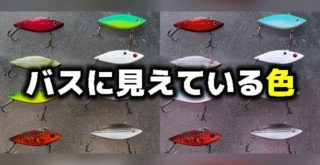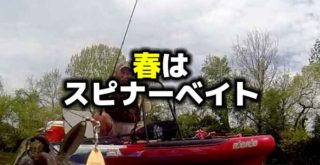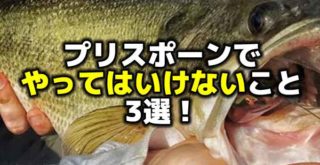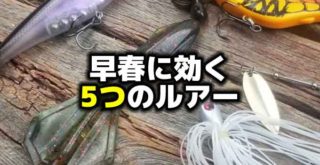フィーダークリークとは何か

Photo by shop karls.com
こんにちは!店長の小山です!
本日は海外サイトより、”What Are Feeder Creeks?”という記事を引用してご紹介いたします。
引用先:shopkarls.com”What Are Feeder Creeks?”(海外サイトです)
皆さんは、フィーダークリークという言葉を耳にされたことはありますでしょうか。
あまり聞き慣れない用語ですよね。言葉を簡単に訳してみますと、クリークというのは中小規模な川のことだと思うのですが、リザーバーなどで言うと本流とは別の支流筋のことを指し、ナチュラルレイクですとメインレイクに流れ込む河川のことを指します。
フィーダーどいうのは川の支流のことを指していますので、フィーダークリークというのは、なんとなくふたつの言葉の意味が重複してしまうのですが、つまりメインではない流れ込みの川や川筋のことを指している感じでしょうか。
自分としても、リザーバーをイメージするのが一番ピンとくるのですが、リザーバーには一般的に主要となる本流筋(メインリバー)があって、そのほかにいくつかの支流筋(クリークアーム)があると思いますが、本流と支流それぞれの川筋について、何か役割があるということなのです。
この記事は、アメリカのタックルショップ「Karl’s Bait&Tackle」のブログ記事で、ここではその支流筋(フィーダークリーク)について解説してくれています。
私としてはリザーバーでの釣りの経験が少ないので特に、支流の意味などについて勉強してきませんでしたが、その解説の内容とはどういうものなのか、ここはひとつ、これを読んで覚えておくことにしましょう。
フィーダークリークとは何か
Creeks flowing into lakes are known as feeder creeks, which provide consistently good bass fishing throughout the year. The section where the creek flows into a natural lake or manmade reservoir features a steady flow of oxygenated water into the lake providing bass with food and more comfortable water temperatures –cooler in the summer and warmer in the winter—than the main lake. The creeks also contain plenty of natural cover for bass including plenty of log laydowns, shallow vegetation and large rocks.
Large feeder creeks on reservoirs widen out and become separate arms of the lake. These feeder creek arms contain a myriad of habitat to help bass reproduce and thrive. The arms usually contain several channel swings and good spawning flats close to those channel swings.
Feeder creek arms tend to have off-colored water in the spring due to rain runoff. These arms also tend to warm up quicker than the main lake during the spring. The water temperature could be 3 to 4 degrees higher on the upper section of the feeder creek than the lower end where it intersects with the main lake.
湖に流入するクリークはフィーダークリークとして知られており、一年を通してコンスタントにいいバスフィッシングを提供してくれます。クリークがナチュラルレイクまたはリザーバーに流れ込むセクションでは、湖に酸素の豊富な水を流し、夏には冷たい水を、冬には温かい水を提供します。クリークには、豊富なレイダウン、シャローのウィード、大きな岩などバスにとって心地良い自然なカバーもたくさんあります。
リザーバーの大きなフィーダークリークは川幅も広くなり、湖のなかでも別のアームとされます。これらのフィーダークリークアームには、バスが繁殖し生育を助ける無数の生息地があります。アームには通常、いくつかのチャネルスイング(チャンネルの曲がり角)や、チャネルスイングの近くに良好なスポーニングフラットエリアがあります。
フィーダークリークアームは、春には雨により悪い色の水が流れる傾向があります。これらのアームはまた、春はメインレイクよりも早く暖まる傾向があります。フィーダークリークの上流の水温はメインレイクと合流する下流より3〜4度高い場合があります。
プリスポーンからのフィーダークリーク
During the prespawn, bass start moving to the back of the feeder creek in the area where they stages on the last section of deep water whether it is a little drop or a bluff edge. Prespawn bass will also cruise gravel points anywhere from 1 to 7 feet deep.
If the lake level is low during the prespawn, throw a suspending stickbait to catch bass and as the water continues to warm switch to a medium-diving crankbait. If heavy rains cause the creek to rise, target flooded shoreline bushes and flip a jig and plastic craw into the shallow cover. Slow-rolling a spinnerbait is another effective way to catch prespawn bass in the bushes.
Prespawn bass will also pull out to the flats when the lake is high. Key on flats that have a bottom contour change of mud to sand mixed with a few rocks. You can catch plenty of bass then with a Carolina-rigged 6 or 8-inch plastic lizard until the fish move in to spawn.
Look for nesting bass in the upper lake section of the feeder creek along the sandy flats with bushes and log laydowns or in short pockets loaded with bushes and wood off the main feeder creek channel. Key on the shallowest cover you can find. Productive lures for spawning bass in the feeder creeks include soft plastic jerkbaits and floating worms in low-water conditions. If the shoreline bushes are flooded, flip a jig-and-craw or run a willowleaf spinnerbait through the cover.
After the spawn, bass in feeder creeks move to the breaks at the end of the flats. The breaks might run out to the 10- to 12-foot range and then break off into the old creek channel as deep as 40 to 50 feet. Bass will stage over a rock pile or couple of stumps on the breaks. A soft jerkbait or topwater walking bait will draw strikes from bass staging on the breaks. As the water continues to warm and bass move deeper, switch to Carolina rigging a French fry worm or cranking a deep-diving crankbait along the breaks.
Dragging a Carolina-rigged French fry or deep cranking will continue to produce bass along the feeder creek channel drops during the heat of summer. Working a 3/4-ounce jigging spoon over brush piles along the drops of the flats will also produce bass. You can also run your boat as far up the creek as possible and catch bass around any current breaks with spinnerbaits, shallow-diving crankbaits, jigs or plastic worms.
プリスポーン期間中、バスはちょっとしたブレイクや崖のエッジなどディープの最終セクションと言える場所からからクリークの奥へ向かって移動し始めます。 プリスポーンのバスはまた、深さ30センチから2mレンジまでの砂利の岬周りを回遊するようになります。
プリスポーン時の湖の水位が低い場合は、サスペンドジャークベイトを投げてバスをキャッチし、水が暖かくなるにつれミディアムクランクベイトに切り替えます。大雨によって川の水位が上昇すると、岸辺のブッシュが水没するので、シャローカバーにジグ&クロ―ワームをフリッピングします。ブッシュのぶりスポーンバスをキャッチする別の方法としては、スピナーベイトのスローロールがあります。
また、湖の水位が高くなると、プリスポーンバスはフラットエリアにも引き出されます。キーはフラットのボトムの質が泥から岩混じりの砂利になるような変化を持つところです。スポーニング段階に入ると、キャロライナリグに6まインチから8インチのリザードワームを使って、多くのバスをキャッチすることができます。
ネストのバスを見つけるなら、湖の上流セクションにあるフィーダークリーク沿いのブッシュやレイダウンのある砂地のフラット、または主要なフィーダークリーク・チャンネルにあるごく小さなワンドにあるブッシュやウッドカバーを探します。可能な限り浅いカバーがキーです。フィーダークリークのスポーニングバスを釣るためのルアーには、水位が低い時はソフトジャークベイトやフローティングワーム、増水で岸辺のブッシュが冠水している場合は、ジグ&クローワームのフリッピングをするか、ウィロリーフのスピナーベイトをカバーに通してください。
アフタースポーンのころ、フィーダークリークのバスは、フラットの端のブレイクに移動します。 ブレイクは3~4.2メートルレンジになるかもしれませんし、クリークチャンネルに落ちる12~15メートルのレンジになるかもしれません。バスは、ブレイクの中のロックパイルやいくつかあるスタンプの上に乗っています。ソフトジャークベイトやトップウォーターのウォーキングベイトは、ブレイクにいる段階のバスからのバイトを引き出します。水温が上がりバスがやや深場へ移動するにつれて、フレンチフライワームのキャロライナリグや、ブレイクに沿ってディープダイビングクランクベイトを巻いてください。
フレンチフライのキャロライナリグをズル引いたりディープクランキングをすると、暑い夏の間はフィーダークリークのチャンネルドロップに沿って引き続きバスが釣れます。フラットの端のブレイクに沿ってあるオダの上に3/4オンスのメタルジグを使用すると、バスがよく釣れます。ボートで可能な限り上流へ向かい、何か流れを遮っているもの(カレントブレイク)の周りでスピナーベイト、シャロークランクベイト、ジグ、ワームを使ってバスをキャッチすることもできます。
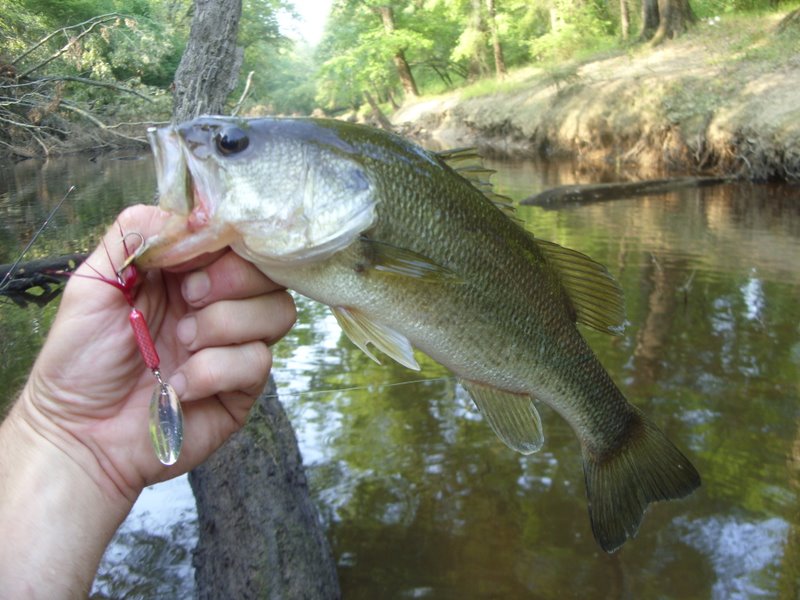
Photo by shop karls.com
秋からのフィーダークリーク
During the fall, the key to finding bass in the feeder creeks is to look for pods of shad. Once you find the baitfish try waking a spinnerbait or run a buzz bait along the flats of the feeder creeks. On windy days, throw a lipless crankbait along the flats. If the weather is sunny and calm, flip a jig to log laydowns or bang a squarebill crankbait into the wood cover to trigger a reaction strike. A soft jerkbait is an effective lure to throw around the wood cover in the morning.
Feeder creek bass fishing will key on the channel swings with transition banks that change from bluff to chunk rock during the winter. A finesse jig with a small craw trailer works best for feeder creek bass if the water is dirty. If the feeder creek is clear and the weather is cloudy and windy, switch to a suspending stickbait.
秋になったら、フィーダークリークのバスを見つけるための鍵は、シャッドの小さな群れを探すことです。 ベイトフィッシュを見つけたら、スピナーベイトのウェイキングか、フィーダークリークのフラットに沿ってバズベイトを通してみてください。 風の強い日には、バイブレーションプラグをフラットで投げてください。 晴れていて凪いでいる場合は、ジグのフリッピングでレイダウンを撃って行ったり、スクエアビルクランベイトをウッドカバーに当てていってリアクションバイトを引き起こします。 ソフトジャークベイトは、朝にウッドカバー周りで投げると効果的なルアーです。
冬のフィーダークリークのバス釣りは、チャンネルスイングの崖からチャンクロックに変化するバンクがキーとなるでしょう。 フィーダークリークの水が濁っている場合は、フィネスジグに小さなクロートレーラーを付けたものが最適です。 フィーダークリークがクリアで、天候が曇っていて風が吹いている場合は、サスペンドジャークベイトに切り替えます。
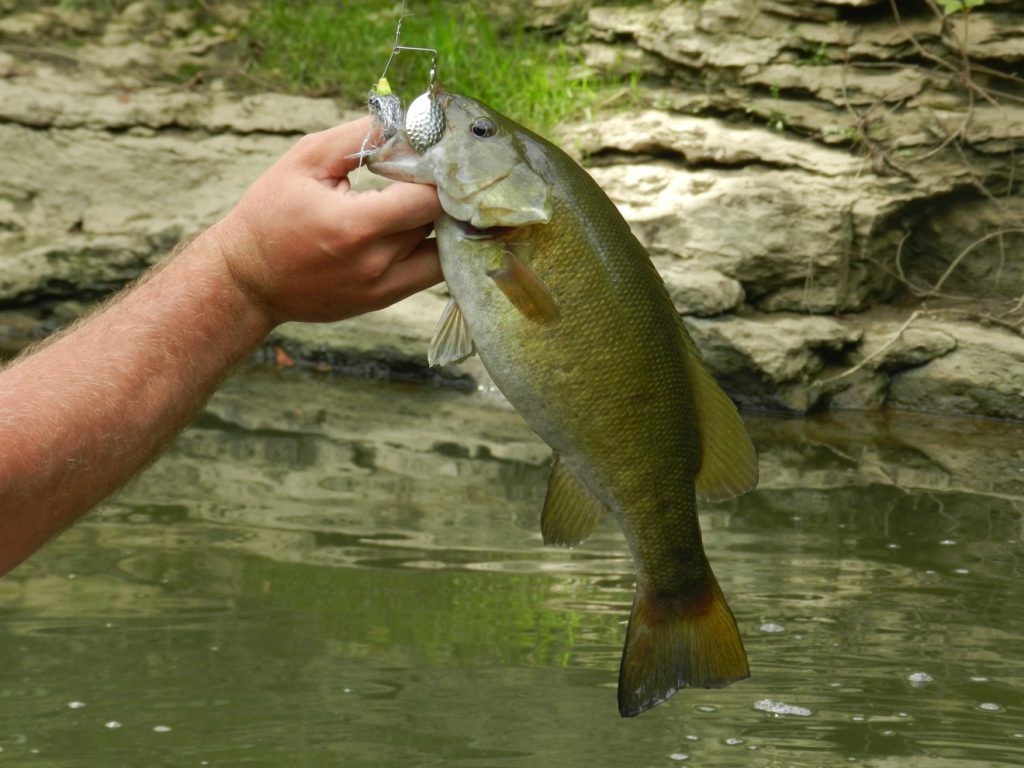
Photo by shop karls.com
フィーダークリーク、支流の釣り。いかがでしたでしょうか。
本流と支流ではバスの生態も違うのだと思いますが、ひとまず、支流におけるバスの四季の行動はこの記事でなんとなくわかりました。
そして今更なことを言うようですが、私も先日、初めて本格的に大規模なリザーバーでバス釣りをさせてもらったところ、私が今まで釣りをしてきたどのフィールドよりも、マンメイドカバー、ナチュラルカバー、地形変化が多いことに圧倒されました。
カバー撃ちや地形変化の釣りが大好きな人にとっては天国のようなフィールド、それでいてその難解さには手を焼かされ、なんとなく釣りをすると釣れるバスが小型になってしまうという、ある意味地獄のような性質も持ち合わせているのだと思いました。
やはりこういうリザーバーならではの性質を勉強して攻略していくことが必要で、分かってくるとめちゃくちゃ楽しいのだろうと思います。
ちなみに、日本ではフィーダークリークという言い方はあまりしませんが、特にこの呼び方にこだわる必要もなく、結局のところ、これまで通りクリークアームですとか、○○川筋、などという呼び方でいいと思います(笑)
また、アメリカのリザーバーは日本のものよりもっとずっと広大ですので、日本のリザーバーで釣りをする場合に、どの程度この記事に当てはめてみるべきかもよく分かりませんが、リザーバーのバス釣りのエキスパートさんでしたらこの記事になにか思うことはあるでしょうし、リザーバー初心者の方でも、ひとまずこの記事の内容を参考に、色々試してみることは勉強になるのではないかと思います。そうして、自分なりにアメリカと日本の違いなどが分かってくると、自分のバス釣りの深みがより出てくるのではないでしょうか。
私ももっとリザーバーの釣りを勉強して行きたいと思います。
それでは、また。
毎度ありがとうございます!














